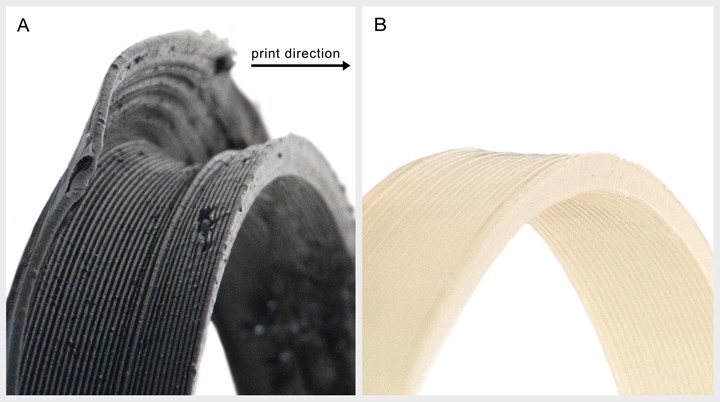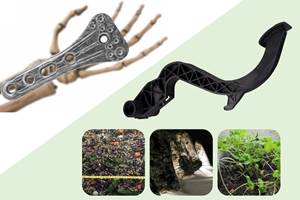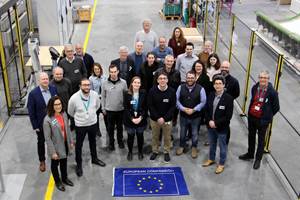NatureWorks Ingeo 3D700 biopolymer reduces LSAM warpage, minimizes print failures
Testing by NatureWorks’ global partners demonstrates a shrink rate less than 0.25% in printed parts and obtainable lower print temperatures due to optimized melt viscosity and microstructure.

Part (A) in black printed with polypropylene (PP) shows notable warpage in the side wall compared with the same part (B) printed with clear Ingeo 3D700 even when print conditions were optimized for each material. Parts courtesy of Dyze Design.
NatureWorks (Minnetonka, Minn., U.S.) continues to grow its portfolio of Ingeo biopolymers designed for additive manufacturing (AM) with the introduction of Ingeo 3D700, a new PLA grade for use in large-format additive manufacturing. NatureWorks notes that monofilaments made with this PLA grade, broadly used in the desktop 3D printing market, have shown notable performance characteristics such as precise detail, good adhesion to build plates with no heating needed, reduced warping or curling and low odor while printing. These properties are said to make Ingeo 3D700 ideal for 3D printing using many different types of printers and for a broad range of printing applications from consumer-level to industrial applications.
In large-format printing, the higher rate and volume of polymer deposition can quickly result in excessive warpage with certain materials, like ABS, or significant shrinkage as with some polyolefins or some general-purpose PLA grades. Warpage pulls the part away from the print bed or causes layer separation, resulting in failed prints. Controlling the polymer-microstructure, NatureWorks’ amorphous PLA grade, Ingeo 3D700, offers a low material shrink rate, which reduces warpage, improves gap fill and adhesion and ensures successful prints.
Further, the need for added reinforcements such as mineral fillers, glass, carbon or cellulosic fiber to reduce part warpage have been minimized. If a specialty print requires additional reinforcement, then cellulose-based additives are easily compounded with Ingeo 3D700, creating a bio-based compound alternative to high-cost petrochemical-based compounds such as carbon fiber ABS.
According to NatureWorks, multiple partners evaluated Ingeo 3D700 for use in large-format fused filament fabrication (FFF) and direct resin-to-print processes with positive results. For example, in addition to going one step further towards reducing warpage in large-format prints beyond previous Ingeo PLA grades designed for 3D printing, Polymaker (Shanghai, China), a leading manufacturer of 3D printing material and filament measured improved Z-layer adhesion when printing with Ingeo 3D700.
Dyze Design (Quebec, Canada) an extruder designer and supplier of components for large-format printers, ran print tests comparing Ingeo 3D850, a grade already known for its low-shrink characteristics, and Ingeo 3D700. The tests, according to the company, indicate that a large-format part printed using Ingeo 3D850 demonstrated a shrink rate of 1.25%. In comparison, the same part printed with Ingeo 3D700 had a shrink rate of less than 0.25%. Retaining a higher throughput rate, Dyze Design was also able to successfully print at a lower temperature of 190ºC without seeing shrinkage or warpage in the part.
Filament manufacturer, MCPP (Helmond, Netherlands), conducted printing tests using filament made from Ingeo 3D700 and demonstrated a 11-13% increase in flow rate due to the optimized melt viscosity, compared to a general-purpose PLA. According to MCPP, this resulted in improved gap fill and adhesion between perimeter layers, suggesting its suitability for fused granular fabrication (FGF) 3D printing.
Ingeo 3D700 is now available for use as resin pellets for direct resin-to-print processes or as filament for FFF process in the U.S., Asia, and Europe.
Related Content
Materials & Processes: Fibers for composites
The structural properties of composite materials are derived primarily from the fiber reinforcement. Fiber types, their manufacture, their uses and the end-market applications in which they find most use are described.
Read MoreGrand Largue Composites, Sicomin enable flax fiber-built Class40 racing yacht
Fibers, fabrics, epoxy resins and adhesives from Sicomin helped realize the lightweight, strong and stiff Crosscall yacht, capable of tackling extreme ocean racing conditions.
Read MoreBioabsorbable and degradable glass fibers, compostable composite parts
ABM Composite offers sustainable options and up to a 60% reduction in carbon footprint for glass fiber-reinforced composites.
Read MoreEuropean SUSPENS project targets green composites production
The 13-partner program will addresses the challenge of reducing the environmental footprint of sandwich and hollow composite structures via bio-sourced resins and carbon fiber precursors.
Read MoreRead Next
Composites end markets: Energy (2024)
Composites are used widely in oil/gas, wind and other renewable energy applications. Despite market challenges, growth potential and innovation for composites continue.
Read MoreCW’s 2024 Top Shops survey offers new approach to benchmarking
Respondents that complete the survey by April 30, 2024, have the chance to be recognized as an honoree.
Read MoreFrom the CW Archives: The tale of the thermoplastic cryotank
In 2006, guest columnist Bob Hartunian related the story of his efforts two decades prior, while at McDonnell Douglas, to develop a thermoplastic composite crytank for hydrogen storage. He learned a lot of lessons.
Read More











.jpg;maxWidth=300;quality=90)











